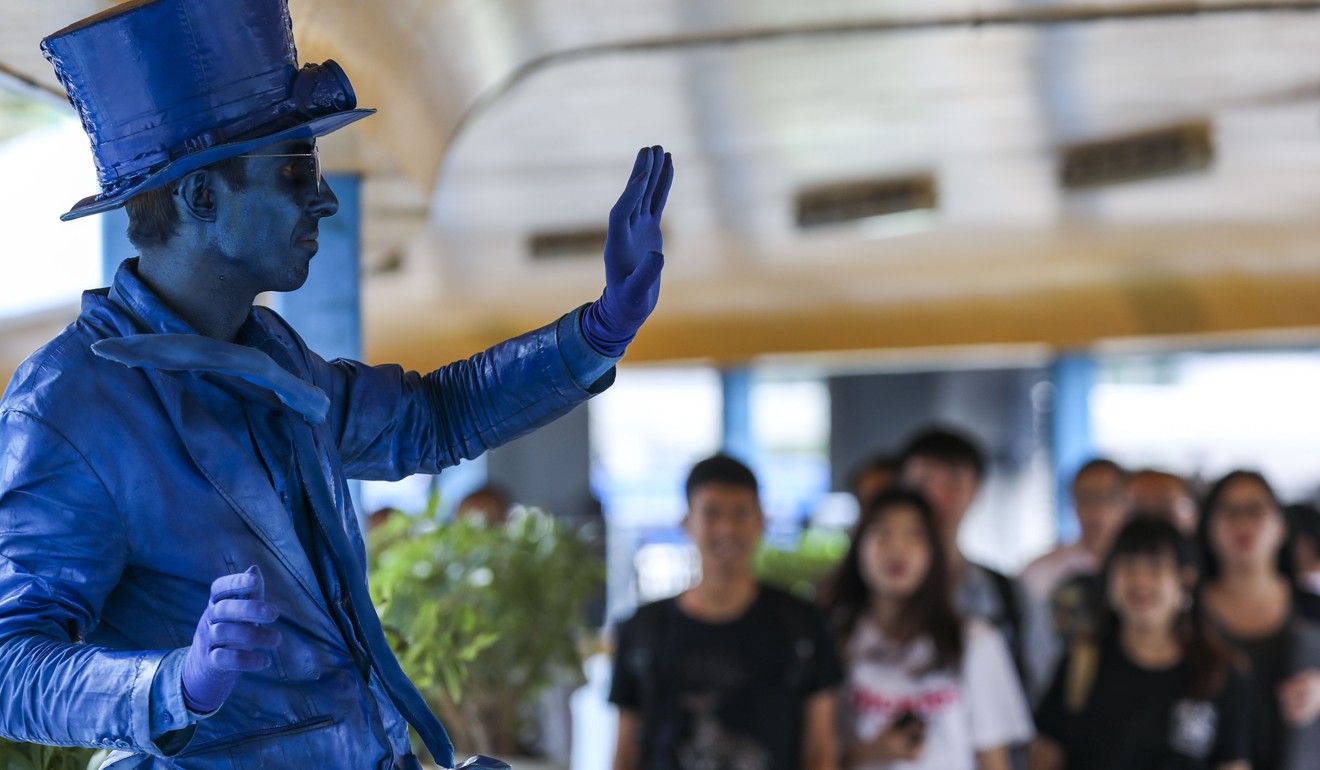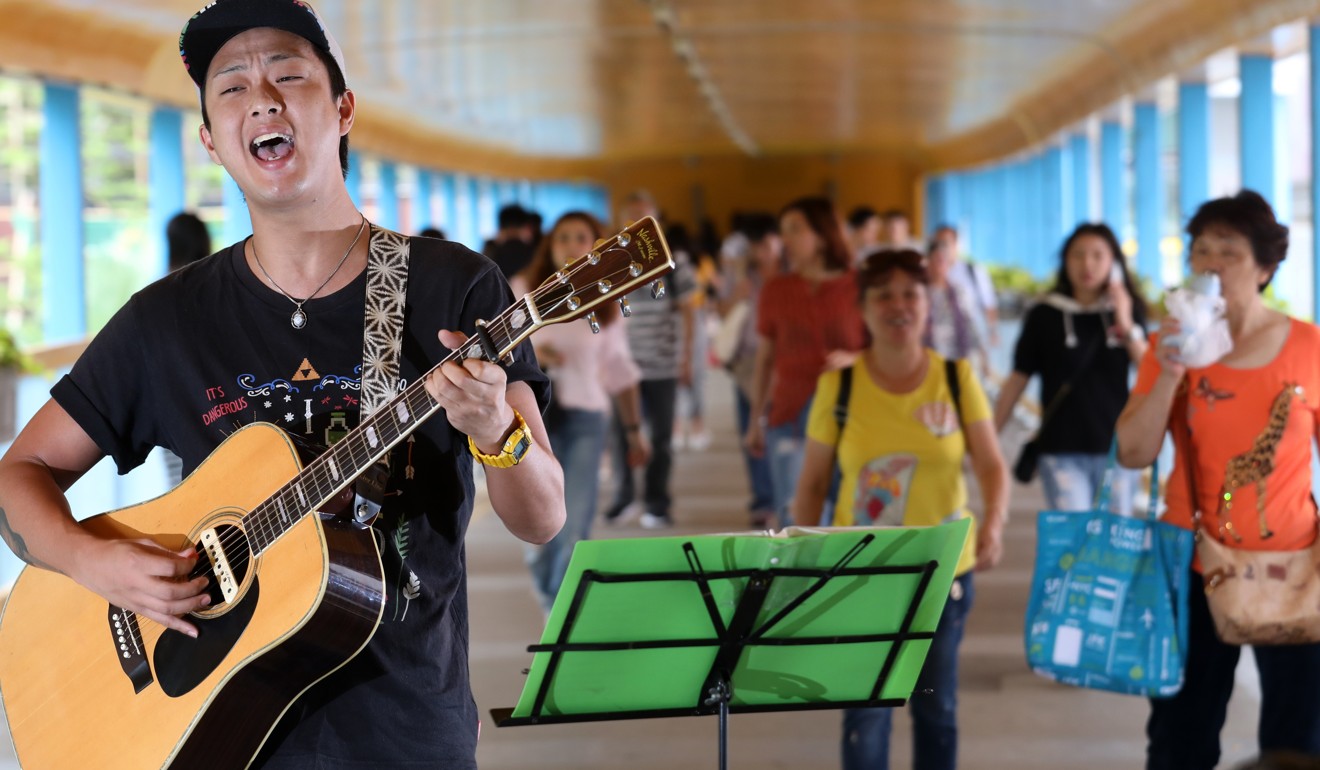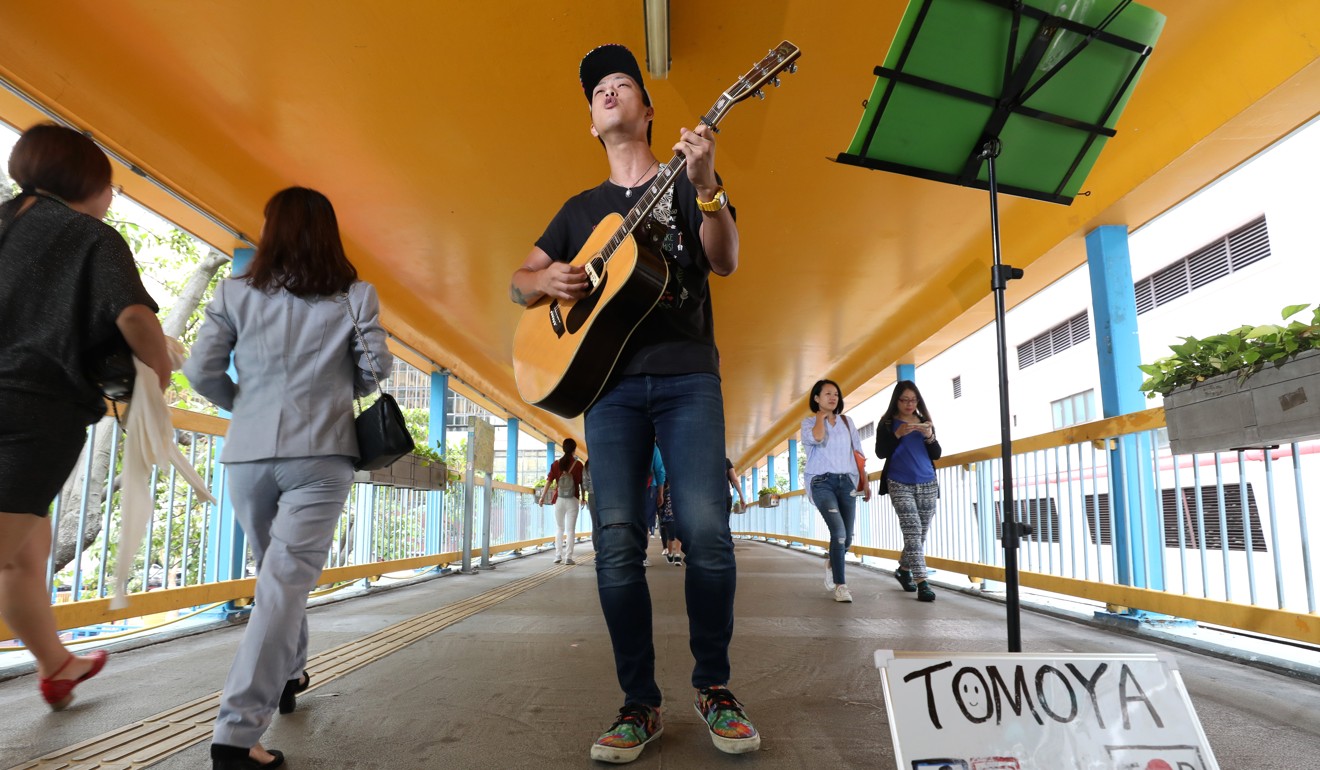
Would you give them money to travel? The rise and fall of Hong Kong’s ‘begpackers’
- Some busk but others simply stand with signs asking for money, or smile to ‘give back positive emotions’
- Cold shoulder from locals who see them as young, idle drifters is driving most away from city, especially with street acts dying out
About a year ago, they seemed to be everywhere in Hong Kong – tourists holding signs on the streets asking for donations to fund their round-the-world trips.
Dubbed “begpackers”, they were on footbridges, outside train stations, and on busy pavements busking, selling knick-knacks or simply holding a note asking for money to support their wanderlust.
The trend, which is also growing worldwide and has popped up in neighbouring countries such as Singapore and Malaysia, has sparked controversy, with some media depicting begpackers as young drifters who refuse to work and are just taking advantage of cheap travel in Asia.
The Caucasian beggars hitting Hong Kong with a vengeance while police turn a blind eye
Critics of the practice argue money should be given to those who are really in need, rather than to serve the travel dreams and pleasures of an able-bodied individual.
The debate on the matter sparked a study by the Hong Kong Polytechnic University, which sought to explore the begpacker culture.
Results of the study – titled “Encountering begpackers” – were published two months ago in journal Tourism Recreation Research. Associate Professor Denis Tolkach, co-author of the report, says: “A lot of mainstream media reports and social media posts condemned these begpackers without actually speaking with them to learn their real stories.
“Most people would just ignore them. Some gave funds because they were convinced that the begpackers were foreigners in trouble, while others did so because they thought busking begpackers made the atmosphere more interesting.”
Can Hong Kong’s street performers get some love ... and more Mong Kok busking space?
The study noted that Hong Kong, as an affluent Asian city, is a primary destination for begpackers because of its status as a transport hub and a relatively relaxed visa policy for travellers who pick the city as an entrance point for an exotic experience in the region.
But others have noted that Hong Kong also has one of the worst rich-poor divide globally, with more than 1.3 million people in the city living below the poverty line. With so many residents in need of help just to get by, the presence of begpackers, who are asking for money to travel, comes across as audacious or tone deaf to most locals.

While the researchers agreed that criticisms against begpacking might be justified, they concluded that the media could have misinterpreted the phenomenon to some extent.
The study involved interviews with eight begpackers in Hong Kong between May 2017 and January 2018. Four respondents were buskers, two sold photos, and two just stood with signs asking for money.
Judge grants temporary ban on busking at Times Square shopping centre in Hong Kong
As part of the PolyU research, a social experiment was also conducted in which a team member posed as a begpacker, while other members approached passers-by to document their reactions to the trend. The most notable finding from the study was that the reactions of the public varied the widest towards begpackers who were busking and those who simply begged.
Busking is not begging
Pawel Sochacki, who calls himself “The Blue Man”, was a begpacker the Post spoke to. He insists he is a street artist.
“People are free to donate money if they like what they see, but I never beg for money. In fact, I don’t like people who sit around and just beg for travel money – I think they should get up and do something nice for the local community,” says Sochacki, visibly agitated by the comparison.

After finishing high school at 19, Sochacki left his hometown of Jelenia Góra in Poland for London, where he spent almost seven years as a pastry chef. Fed up with workplace stress and politics, he decided to travel the world.
For the past three years, he has been around Asia, performing on the streets of South Korea and Hong Kong as a living statue.
His latest act involves being decked out in blue body paint, and standing motionless on the street for two to three hours daily, occasionally shifting ever so slightly into a new position to ease the numbness from the physically taxing stunt.
“Many Hongkongers walk past the same places and see the same things every day,” says the 33-year-old. “I want to make their daily routine more interesting by being something unusual, something out of the blue.”

Back home, he says, many of his friends who have completed university end up working at places like McDonald’s.
“I, on the other hand, have heard really amazing stories from the people I’ve met in different countries,” gushes Sochacki, who says he has been to China, Japan, Vietnam, Cambodia, Laos, Thailand, Malaysia – and more.
In pictures: End of an era for Mong Kok street performers
Sochacki met and fell in love with his girlfriend, Sabina Boguszewska, 28, while performing in South Korea about a year ago. Like Sochacki, Boguszewska is a travelling street artist from Poland. She too, performs as a living statue. Boguszewska is a university graduate with a degree in architecture, but never pursued a career in the field.
“She finds it boring,” explains Sochacki, who now travels the world with Boguszewska. “We would rather be on holiday all the time.”
We would rather be on holiday all the time
He sets up his act by unfolding a plastic stool. He then props up a cardboard sign scrawled with the barely legible Chinese characters: “Your smile is my motivation.”
A woman swoops in and offers some change before scurrying away. He thanks her in English with a thick Polish accent.
“I use this money for transport, food and accommodation,” Sochacki says. He claims he supports his other expenses with an online business, but declines to reveal more details.
Returning from an hour-long break to soothe his aching limbs and joints, Sochacki proceeds to balance on his flimsy stool on a footbridge near Hung Hom.
A local family of three waits patiently for him to settle into his first position before snapping a photo of their little boy posing next to him.
“I appreciate that he’s doing something unique and entertaining,” says the boy’s mother, Jane Sin Chun, who gave Sochacki about HK$20. “If he was just sitting there asking for money, I wouldn’t give him anything.”
In the PolyU study, it was reported that travellers who were simply begging with a sign admitted they did not have any particular talent to busk. One said he did not see the difference as busking was only a pretext to asking for money, while another said he would smile to “give back positive emotions”.
With the recent drop in the number of begpackers in the city, researcher Tolkach says he is aware of the trend but unsure why this is so.
Saying goodbye to Hong Kong
Tomoya Nagayama from Kyoto, Japan, seems to have an answer – the cold reception from Hongkongers is driving begpackers away, whether they busk or beg.
On a Tsim Sha Tsui footbridge, Nagayama, 26, strums his acoustic guitar, cooing a Japanese song. The self-taught musician graduated from college with an engineering degree about a year ago, and has been travelling and busking ever since.

“For me, it’s not about the travel – it’s all about the music and getting exposure. When I’m not playing, I’m writing music and practising,” claims Nagayama, who wants to continue busking and travelling until he is 30.
A middle-aged woman stands next to him as he plays, flashing the peace sign with her fingers as her friend snaps away on her smartphone. A small boy, transfixed by Nagayama, who is smiling between lyrics, is pulled away by his mother.
Mong Kok street performers band together to call for licensing system
Despite the enthusiasm some have shown for them, both Nagayama and Sochacki admit they feel they may be outstaying their welcome in the city.
For Sochacki, it is his second time performing in Hong Kong but he says it may be his last. His first was a year ago, when he stayed for five months. He says he feels Hongkongers were more welcoming towards street artists then.
“With the closure of the Mong Kok pedestrian zone, good artists just don’t perform on the streets any more because they’re not appreciated,” says Sochacki. “I also get mixed messages from police – some say it’s OK for me to perform, others say it’s not.”
Someone called the police on me. I think it’s because many ... feel contempt for me – well, not just me, but Hong Kong buskers
Since 2000, the Mong Kok pedestrian zone had been a popular open space for buskers and street artists. It was shut down in August after residents made more than 1,200 complaints to authorities over noise and obstruction. Meanwhile, Times Square mall in Causeway Bay is seeking multiple court injunctions to ban unapproved busking and any other forms of street performance from its open piazza.
Sochacki says the money is not great, either. Once a week, he has to add a fresh coat of paint to his costume, which requires 20 cans of spray paint.
Having been in Hong Kong for about two weeks, Sochacki and his partner have also just rented a subdivided flat 15 minutes away from Tsim Sha Tsui for HK$7,000 a month.
He claims he makes only HK$60 to HK$100 a day from his street art, and the rest is from his internet business.
Meanwhile Nagayama appears to have had more success in earning tips, and praises Hongkongers for their generosity. But while he stops short of revealing how much he makes daily on average, he says he has to fork out HK$100 to HK$300 a night at youth hostels around the city.

The lifestyle, Nagayama says, is unsustainable for him and he will be leaving earlier than planned.
“Someone called the police on me. I think it’s because many older Hongkongers feel contempt for me – well, not just me, but Hong Kong buskers, too.”
Local street singer Kit Cheung Kit-ying agrees, saying authorities are tightening their grip on street performers in general.
“Unfortunately, Hongkongers are also critical of street artists, and they will probably view begpackers simply as undeserving beggars, even if they’re performing,” Cheung says.
Begging is illegal in Hong Kong. Selling knick-knacks, or hawking, may also be illegal for causing obstructions. Busking, however, is legal, unless it causes a nuisance or obstruction.

Civic Party lawmaker Tanya Chan says while it is a pity to lose international visitors who showcase their talents in Hong Kong, those who busk or sell knick-knacks may actually be breaking the law as immigration regulations state visitors cannot be employed in the city.
While I cannot see how travellers who simply beg can make a positive impact on the city ... tourists who sell knick-knacks or busk can make it more vibrant
“There is a discussion under way on whether laws and policies should be altered to grant greater freedom for Hong Kong citizens to busk or hawk,” Chan says. “I believe once that discussion is settled, we can apply a similar standard to begpackers.
“While I cannot see how travellers who simply beg can make a positive impact on the city, it’s been said that tourists who sell knick-knacks or busk can make it more vibrant,” she adds.
Despite the difficult environment, Nagayama remains positive and is devoted to his cause. He believes the only way to get better as a musician is through performing for different audiences in different locations.
He aims to save enough money to stay in American music capitals – such as New Orleans and Tennessee – next year, where he plans to spend more time honing his craft, as well as purchase a new guitar and amplifier.
“I want to be a great artist like Eric Clapton,” Nagayama says. “I’m so focused, I don’t even want a girlfriend,” he declares, laughing.


